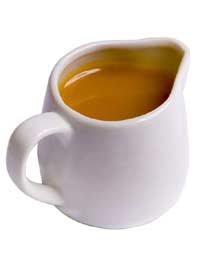Types, Methods and Consistencies of Sauces

Types, Methods and Consistencies of Sauces
Sauces can make a meal. The addition of a well made sauce to the simplest of sweet or savoury dishes can transform it into something really special. They don’t have to be elaborate or complicated-thick onion gravy with bangers and mash is a sauce that can transform the meal, as is a creamy cheese sauce with cauliflower. Simple but effective.
Types of Sauce
Basic sauce types include: roux-based white and brown sauces that are commonly used as the foundation for other sauces and soups; egg-based sauces for richer, creamier, dishes; tomato-based sauces that are extremely versatile and can be used on their own, as a base for soups and stews, or as one of the most popular sauces in Italian recipes; cold sauces to accompany vegetable and fish dishes; fruit and herb sauces that are often served with meats (cranberry and mint for example.)
Roux-based sauces are made with a combination of flour and butter that have a liquid added to them and, frequently, further ingredients to complement a particular type of food. These include sauces like gravy, béchamel sauce, cheese sauce, parsley sauce, mushroom sauce, onion sauce and numerous variations, including veloute sauce. Veloute means velvety in French and with the use of egg yolks and cream in this white sauce, it’s easy to see why! Further compounds of white and brown sauces include the exotic-sounding Allemande sauce, Chantilly, Demi-glace, Espagnole, Mornay and Supreme. There are hundreds of variations on the basic savoury sauces.
Methods Used in Sauce-Making
When making a roux base, the most important factors to remember are to use the right flour/fat mixture and heat at the correct temperature. This stage is the single most important of making your sauce and needs complete attention! (For tips on how to rescue sauces, see ‘Useful Sauce Tips & Serving Suggestions’.)
Blending is another method of making a white sauce base. Plain flour or cornflour is mixed to a smooth paste with a little cold milk. Hot milk from a pan is poured over the paste and the combined ingredients then returned to the pan, brought to the boil, gently simmered, then butter and seasoning added.
Fry onions in butter, then add the flour and the roux is made with the onions in the same pan. The addition of milk, or a combination of stock and milk, helps to create a delicious onion sauce.
Egg yolks can be beaten on their own, with cream, butter, or with stock, to add richness to certain sauces. Home-made mayonnaise and custard are two of the simplest to make but taste great.
Sauce Consistencies
Although it depends, to some extent, on personal preference and the type of meal a sauce is to be served with, there are some guidelines to remember in order to achieve the desired consistency of a sauce.
Apart from eggs and cream, thickening agents most commonly used for sauces are flour, cornflour and arrowroot. A beurre-manie is useful for thickening stews, too, and is made by kneading an equal amount of butter and flour into a paste (using fork or fingers) that can then be added, in pieces, to the hot liquid. Stir or whisk until the butter has dissolved and the flour dispersed, and the sauce is thick and smooth; but take care that the sauce does not boil.
Thickening is also achieved by reducing (boiled down until the liquid becomes less and thicker)to the desired consistency.
In general, a sauce should look appetising and pour or coat-according to its purpose-to give your meals that extra something.
- How to Make Chutney
- How to Make Jam
- Useful Sauce Tips and Serving Suggestions
- Easy Steps to Egg-Based Sauces.
- Roux-Based Sauces: What, How and When
- How to Make a Simple Tomato-Based Sauce.
- Vegetable Stock: Tips On How to Make and Use
- Game Stock: How to Make and When to Use
- Fish Stock: The Basics
- What is Brown Stock and How is it Made?


Re: Types of Pastry
I have never seen samosas made with filo. While the dough is thin it is very different from filo. I have made both and the process is very different.
Re: How to Make Perfect Short Crust Pastry
Would you please provide the links for: 1. Apple tart or galette crust 2. Apple pie crust 3. Can an enriched…
Re: Types of Pastry
Have you a recipe for hard pastry used for encasing joints of meat and poultry before baking in an oven at low temperature? I think it is called…
Re: Making Fruit Pies and Crumbles
i make crumble with corn corn flakes i make them into crumbs and the whole thing taste nice
Re: Types of Pastry
yes i like it crusty but also a bit moist. i think it adds the fun if it's smooth and moist. i don't really like it if it is flaky. it also needs a…
Re: Types of Pastry
what is the difference between flaky pastry and rough puff pastry
Re: Types of Pastry
Pastry is kinda complicated but at some point it's under stood thanos for the information that helps us learn
Re: Types of Pastry
My dad left to the shop to get some pastry five years ago, has anyone seen him??
Re: Types of Pastry
MY NAN has some nice pastry if someone wants some
Re: How to Make Chutney
I allowed my chutney to go cold before I put it in jars....will it compromise the taste or how long it will last?